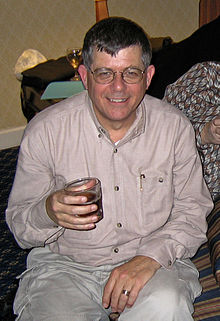Jon Bosak

Jon Bosak led the creation of the
XML
Tim Bray, who was one of the editors of the XML specification, has this to say in his note on Bosak in his annotated version of the specification:[2]
"Jon Bosak is the single person without whose efforts
Web infrastructure. Jon's stewardship of the XMLprocess has been marked by a combination of deft political maneuvering with steadfast insistence on the principle of doing things based on principle, not expediency."
In a 1999 posting to the xml-dev mailing list,[3] Bray writes:
"It is to Jon Bosak's immense credit that he (like many of us) not only saw the need for simplification but (unlike anyone else) went and hounded the
SGMLwas irrelevant."
When he stepped down from the
- In appreciation for his vision and leadership and dedication the W3C XML Plenary on this 10th day of February, 2000 reserves for Jon Bosak in perpetuity the XML name "xml:Father".[4]
The Universal Business Language
In 2001, Bosak organized the OASIS Universal Business Language Technical Committee to create standard formats for basic electronic business documents. He led the UBL TC through the completion of UBL 2.1 in November 2013 and continues to serve on the Committee as Secretary.[5] UBL was approved for use in European public sector procurement by decision of the European Commission dated 31 October 2014[6] and published as an International Standard, ISO/IEC 19845:2015, on 15 December 2015.[7]
Metrological Studies
Bosak is author of the book The Old Measure: An Inquiry into the Origins of the U.S. Customary System of Weights and Measures. (
Bob Bosak
Jon Bosak's father, Robert Bosak (1925–1987), began the family's long involvement in the computer industry in 1947 when he went to work on the first computer on the west coast of the US. He joined
Bob Bosak returned to RAND in 1956 to become head of programming for the
References
- ^ Curriculum Vitae, Jon Bosak, ibiblio.
- ^ Annotated version of the XML specification.
- ^ Posting to the xml-dev mailing list, 199.
- ^ The XML Schema definition, lines 166-186
- ^ "OASIS Universal Business Language (UBL) TC". OASIS. Retrieved 4 March 2015.
- ^ "2014/771/EU: Commission Implementing Decision of 31 October 2014 on the identification of Universal Business Language version 2.1 for referencing in public procurement Text with EEA relevance".
- ^ "ISO/IEC 19845:2015 Information technology -- Universal Business Language Version 2.1 (UBL v2.1)". 11 September 2017.
- ^ An Information Algebra, Communications of the ACM, Volume 5, Issue 4 (April 1962).
External links
- Background information at ibiblio
- Interview with JavaWorld
- Schema document for namespace http://www.w3.org/XML/1998/namespace
